Autumn Trail
Autumn trail through the Botanic Garden
 |
|
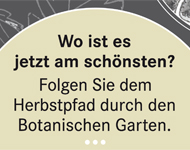 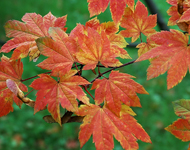 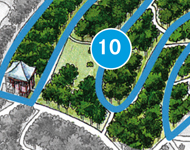 |
|
| There is nowhere better to experience autumn in several regions of the Earth at one and the same time or to enjoy autumnal colours and scents. By following our suggested route, you will discover those plants and parts of the Botanic Garden that are now at their most beautiful. Of course you will also find many plants that are well worth seeing in other parts of the Garden too. We wish you a pleasant trip through the plant world. Plants bloom, fruit, smell and change colour earlier or later in the year depending on the weather conditions. |
|
 |
|
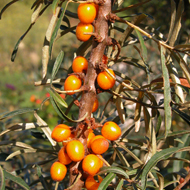 |
This is when nature shows why the German word for autumn, Herbst, originally meant ‘season of fruits’ and is related to the English word ‘harvest’, the Latin carpere (to pick), the Greek karpos (fruit) and the Indo-European sker (to cut). In the dune landscape the orange-coloured, Vitamin C-rich fruits of the Common Sea-Buckthorn and the red fruits of the European Holly gleam brightly. By eating these fruits, birds disperse the seeds included in them. |
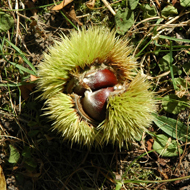 |
In the autumnal mountains, the Alpine Daphne and the Sweet Chestnut, its fruit enclosed in prickly packages, are a delight for the eye. Along the way to the medicinal plants garden you will be dazzled by the leaves of the Persian Ironwood Tree with their many shades of red and yellow. |
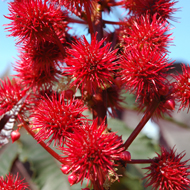 |
In the medicinal plants garden the Castor Oil Plant even now still bears flowers alongside its impressive fruit clusters. Its seeds yield castor oil and are used as a source for renewable energy. Can you see the infructescence of the artichoke plant? At the bud stage, its flower heads are a culinary treat! |
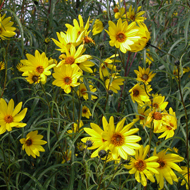 |
In the systematic section sunflowers glow, and the Japanese Knotweed is also still in full bloom – an invasive plant, it was introduced into Germany by humans and in some places is edging out the native flora. Another particularly impressive sight is the stately Giant Cane, whose stems are used to make the reeds in woodwind instruments. |
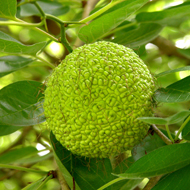 |
In the arboretum discover the Osage-orange with its spherical, wrinkly patterned multiple fruits. Just like the related fig it contains a milky sap. Its wood was used by North American Osage Indians to produce tomahawks and bows. |
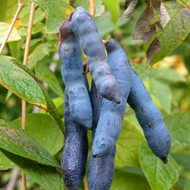 |
On humid days the decomposing leaf litter of the Katsura Tree exudes its characteristic bakehouse smell, which is why it is commonly known in Germany as the ‘Cake Tree’. At the Gertrud Schaub pergola the fruits of the hardy Trifoliate Orange are resplendent, as are the long lilac fruits of the Blue Cucumber Shrub, also called Dead Man’s Fingers. A little further along the path the large fruits of the delicious quince and the smaller fruits of the Japanese Quince are conspicuous by their bright colours. |
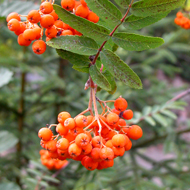 |
After passing the Purple Smoke Bush with its long-haired fruit stalks as well as different varieties of acer you arrive at the fruiting rowan trees, among them the Whitty Pear, which grow in close proximity to the rose pavilion. With its sharp thorns, the Cockspur Hawthorn is most impressive. |
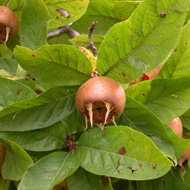 |
What would the autumn be without wine? Take a detour to the vine pergola and admire the different grapevine species. Further on you will come across the Common Medlar, whose highly prized fruits are softened by the first frosts. |
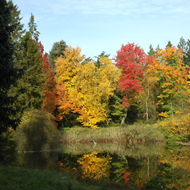 |
Gazing out across the American lake, you feel yourself transported into an ‘Indian summer’. The information board on the bridge will tell you why in autumn the leaves of deciduous trees turn from green to yellow, orange, red and brown. Particularly striking is the foliage of the American Sweetgum and the Tulip Tree. The prairie is aglow with the orange leaves of the Staghorn Sumac trees, the yellow flowers of the goldenrods and the brightly coloured flowers of various species of aster. |
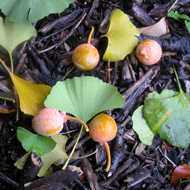 |
In Japan, the leaves of the Ginkgo Tree are a splendid blaze of yellow, visible from afar. The fleshy seeds of the female trees exude the pungent smell of rancid butter – in complete contrast to the aromatic foliage of the nearby Katsura Tree. The lilac fruits of the Beautyberry make it easy to understand how it got its English vernacular name. |
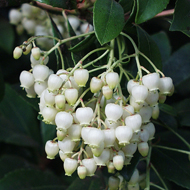 |
Especially on cool autumn days the greenhouses offer a perfect end to your journey through the world of plants. With the onset of the autumn rains, the plant world around the Mediterranean awakens to new life after the summer drought. In the Mediterranean Greenhouse the Ivy-leaved Cyclamen and the Strawberry Tree are among the plants in bloom. |
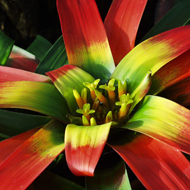 |
In other greenhouses bromeliads, fuchsias and begonias as well as blood lilies easily allow you to forget which season it is. In November the Tea Plant gets the camellia flowering season off to a wonderful start. |
| Spring, Summer and Winter | ||
| For orientation: Map of the garden und die Greenhouses... |
